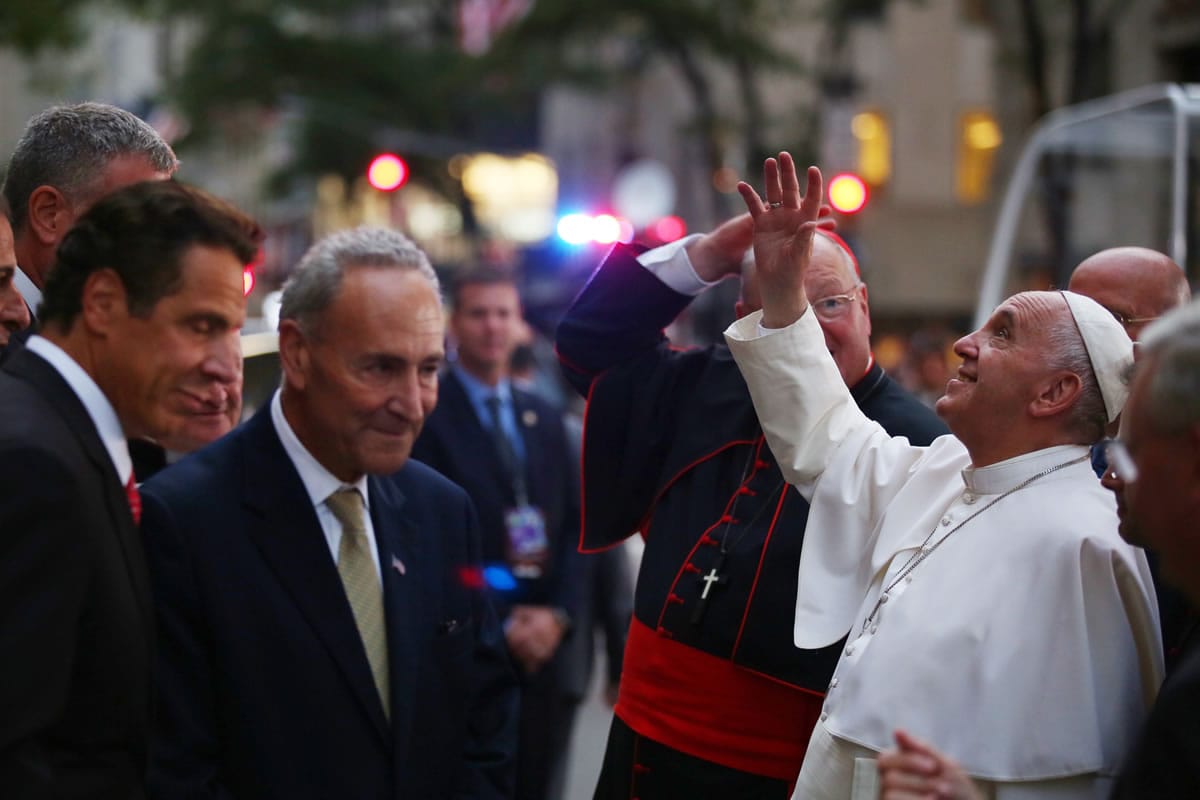The pope’s entourage is about 100 people, which makes it less of a flock and more of a herd. No, His Holiness is not trailed by a stylist and personal trainer, although there is a papal physician and a few attendants in charge of wardrobe. When you’re traveling as both a head of state and the leader of a 2 billion-member church, you need some helpers.
The traveling papal entourage is a modern creation. A pope hadn’t stayed overnight in the United States until John Paul II, in 1979. With six weeks’ notice, the Vatican requested 400 hotel rooms in Boston, but the whole city was booked. (A local hotelier reportedly advised them to try Providence, R.I.)
Over time the entourage has shrunk, as Francis purged stowaway cardinals and other hangers-on, but the local, on-the-ground operations have gotten bigger and bigger. Here are the seven types of members of the papal entourage that’s boomeranging along the Eastern Seaboard this week:
1. Members of the papal household. This group includes Sandro Mariotti, alternately called the pope’s valet, butler or assistant. This is the guy who makes sure the pope’s hands are always free. When someone gives something to Francis, Francis gives it to Mariotti, who’s also on umbrella duty and is in charge of making sure the papal suitcase is packed and unpacked. Also in this group: Vatican secretaries, the physician and papal household prefect “Gorgeous George,” aka Archbishop Georg G?nswein, whose Old Testament good looks landed him on the cover of Italian Vanity Fair a couple of years ago.
2. The masters of ceremonies. Led by Monsignor Guido Marini, this team coordinates the pope’s liturgical events: Masses, vespers, anything requiring props and public prayer. John Paul II liked colorful celebrations, while Benedict XVI preferred a sedate liturgy. Marini’s job is to thread papal preferences into the pageantry.
3. The Roman Curia. Heads of various departments in the Vatican administration will be along for the ride, such as the secretariat of state and administrators who liaise with jurisdictions on the pope’s itinerary.
“He’ll be speaking with the U.N., so people at Secretariat of State’s office that deal with the UN will be there,” says the Rev. Mark Morozowich, who worked in the Vatican press office under John Paul II and is interim provost of the Catholic University of America. “He’ll be speaking with Congress, so people on the government relations desk will most likely be here.”
4. The security team. This group is a combination of Vatican City police officers and the Pontifical Swiss Guard — which has defended the pope since the year 1506 — plus local counterparts (the U.S. Secret Service in this case.) This visit’s security operation is one of the largest in U.S. history; the federal budget allots $4.5 million a year to handle “national special security events” like this one. Trivia: In 1979, the overtime wages alone for local law enforcement covering John Paul II’s 34-hour visit to the District cost nearly $1 million.
“A colleague of mine went with (John Paul II) to Africa and talked about how at the end of the trip, the reporters were absolutely thrashed and he was pumped,” says Greg Erlandson, publisher of Our Sunday Visitor, a Catholic publishing company. John Paul II “was a classic extrovert. He liked getting out of the Vatican and drawing energy from the people.”
Francis is also a people person, so the tension in his entourage is always one of proximity and availability vs. safety and security.
5. The communications team. La Sala Stampa, or the Holy See Press Office, is led by the pope’s spokesman, the Rev. Federico Lombardi, and includes Vatican radio and TV services and the Vatican newspaper l’Osservatore Romano. There are several people who tweet for Pontifex, but most remain in Rome. Also in this group: Monsignor Mark Miles, the American interpreter attached to the pope’s hip during the trip.
6. “The Vat Pack,” aka the press corps. This group is made up of about 70 people. The press corps is kept at the back of the pope’s private plane, sometimes referred to as “Shepherd One.” Francis and company flew on a commercial Alitalia jet to Havana and will fly an American Airlines jet out of Philadelphia. John Paul II and Benedict XVI enjoyed a customized first-class experience — with the front of the plane transformed by the carrier into a hotel-like room — but Francis has insisted that he sit in a regular row in standard first class.
“When we were flying around Latin America in July, he was sitting in the front row,” says Cindy Wooden, who is the Rome bureau chief for Catholic News Service and has flown on the papal plane more than two dozen times. “If you look down the aisle, you can see his elbow covered in white, or his zucchetto” — the yarmulke-like cap atop his head.
7. One lucky Vatican staffer. Each time he travels out of Italy, Francis plucks one layman or laywoman from the Vatican to join his entourage. For this trip, Francis invited Valentina Ambrosi, an artist in the Vatican’s mosaic studio, according to Catholic News Service.



